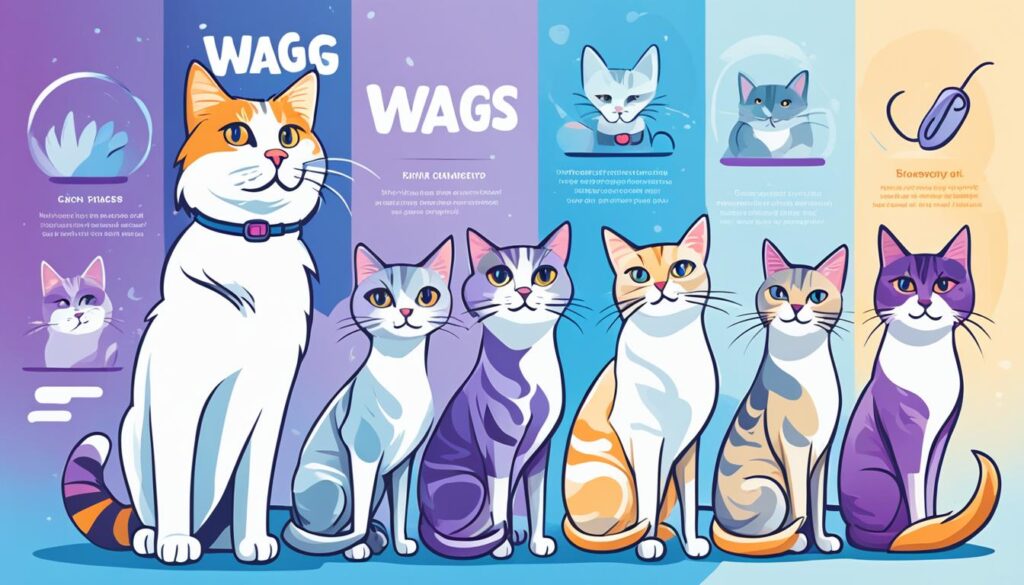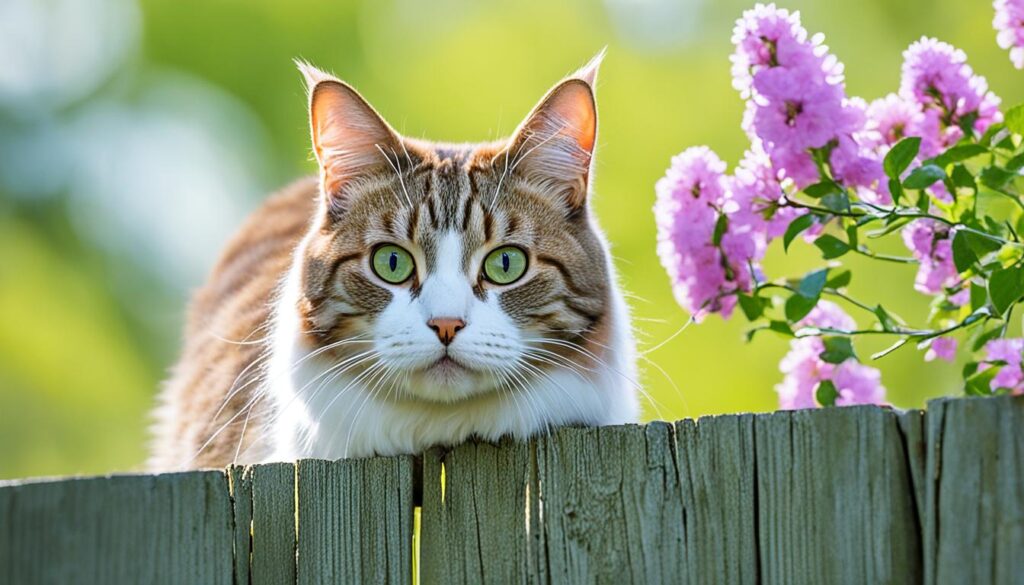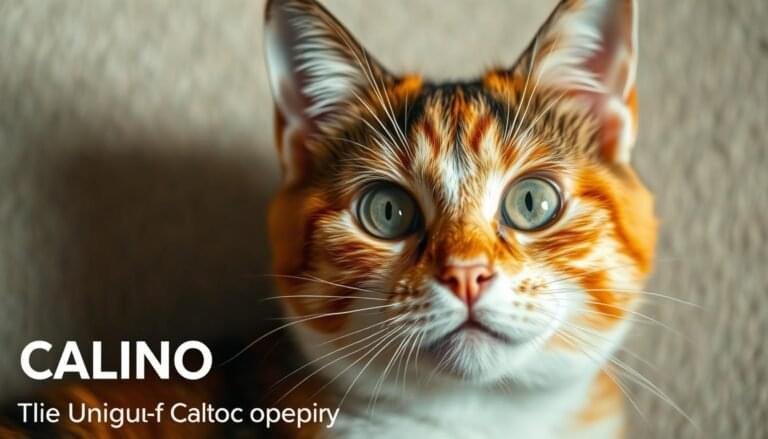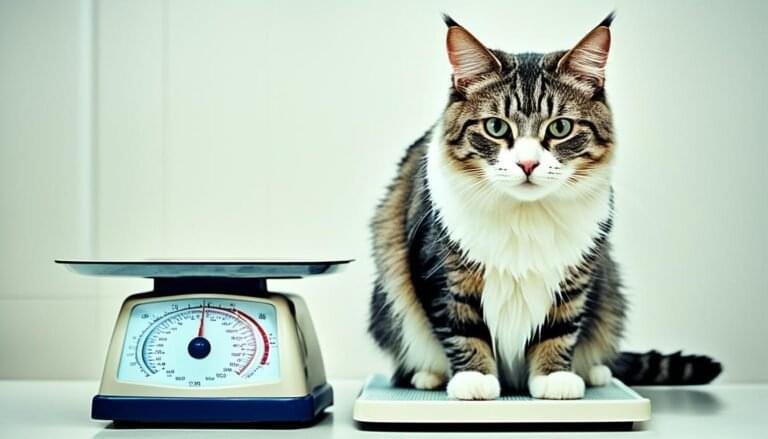Did you know that cats wag their tails for various reasons? Tail wagging is not exclusive to dogs; in fact, cats have their own intricate language of tail movements that communicate their emotions and needs. Understanding cat tail wagging behavior can provide valuable insights into your feline companion’s behavior and strengthen your bond. Let’s delve into the fascinating world of cat tail language and discover the reasons behind this unique form of communication.
Why do cats wag their tails? Key Takeaways:
- Cat tail wagging is a form of communication that signals various emotions and needs.
- Decoding cat tail language can help you understand your cat’s behavior and avoid misunderstandings.
- Pay attention to the position, movement, and shape of your cat’s tail to interpret their emotions accurately.
- Cat tail wagging can indicate readiness for interaction, affection, fear, pain, or sleep twitching.
- Understanding cat tail language is essential for building a better relationship with your feline companion.
Understanding Cat Tail Language
Cats have a unique way of communicating with us and other animals through their body language. Their tail movements, along with their eyes, ears, and body postures, play a significant role in conveying their emotions and needs. Decoding cat tail language is essential for understanding how your cat feels about specific interactions and environments.
By observing and interpreting cat tail wagging, you can gain valuable insights into your cat’s behavior and emotional state. Understanding cat tail language allows you to identify if your cat is happy, fearful, or in pain, enabling you to provide appropriate care and address their needs.
Let’s explore the different aspects of cat tail language to better understand our feline companions:
1. Positions and Movements:
Cats use various positions and movements of their tails to communicate different messages. Here are some common examples:
- A straight and upright tail indicates a friendly greeting and confidence.
- A tail shaped like a question mark or hook signifies a happy and approachable mood.
- A low tail position can indicate fear or anxiety.
- If a cat’s tail is fluffed up, it suggests they are startled or frightened.
These tail movements provide valuable insights into your cat’s emotional state and can help you respond appropriately.
2. Context and Environment:
The meaning of cat tail wagging can also vary depending on the context and environment. Cats may exhibit different tail language in various situations:
- When a cat wraps their tail around your hand or arm, it can be a sign of affection.
- A fluffed up tail indicates they feel threatened or endangered.
- Some cats twitch their tail while sleeping to acknowledge your presence.
- If a cat waves its tail while lying down, it may signal pain or illness.
Being aware of these specific situations can help you interpret your cat’s tail language accurately and respond accordingly.
3. Tail Language and Overall Behavior:
Understanding cat tail language goes hand in hand with interpreting their overall behavior. Combining observations of their tail movements with other forms of communication, such as vocalizations and body postures, provides a more comprehensive understanding of your cat’s emotions and needs.
By decoding cat tail wagging, you can develop a stronger bond with your feline companion and ensure their well-being and happiness.
| Cat Tail Position | Meaning |
|---|---|
| Straight and upright | Confidence and friendly greeting |
| Question mark or hook shape | Happy and approachable mood |
| Low position | Fear or anxiety |
| Fluffed up | Startled or frightened |
The Different Meanings of Cat Tail Movements
Cat tail movements are a crucial aspect of feline body language. Understanding the various meanings behind these movements can provide valuable insights into your cat’s emotions and intentions. By decoding cat tail wagging, you can better communicate and connect with your furry companion.
Straight and Upright Tail: Friendly Greeting and Confidence
A cat with a straight and upright tail is typically expressing a friendly greeting and confidence. When your cat approaches you with a tail held high, it signifies that they are happy and content in your presence. This confident posture is often accompanied by relaxed body language, indicating a positive and sociable mood.
Tail Shaped like a Question Mark or Hook: Happy and Approachable Mood
If you notice your cat’s tail forming a question mark or hook shape, it indicates a happy and approachable mood. This tail position often accompanies a playful demeanor and an eagerness to engage in interactive activities. It’s a clear signal that your cat is ready for some quality playtime and companionship.
Low Tail Position: Fear or Anxiety
A low tail position can be a sign of fear or anxiety in cats. When a cat tucks its tail between its hind legs or holds it close to the ground, it suggests that they are feeling apprehensive or threatened. This defensive posture is often accompanied by other stress signals, such as flattened ears or dilated pupils.
Fluffed Up Tail: Startled or Frightened
If you notice your cat’s tail becoming fluffed up, it indicates that they are startled or frightened. When a cat feels threatened or senses danger, they puff up their tail to appear larger and more intimidating. This defensive behavior is an instinctual response aimed at deterring potential threats and ensuring self-preservation.
By observing these cat tail signals, you can gain valuable insights into your cat’s emotions and respond accordingly. Whether it’s recognizing their friendly greetings, playful mood, fear, or distress, decoding cat tail wagging allows for more effective communication, fostering a stronger bond between you and your feline friend.
Summary of Cat Tail Meanings
| Tail Position | Meaning |
|---|---|
| Straight and Upright | Friendly greeting and confidence |
| Question Mark or Hook Shape | Happy and approachable mood |
| Low Position | Fear or anxiety |
| Fluffed Up | Startled or frightened |
Cat Tail Language in Specific Situations
Cat tail language is a fascinating form of communication that can vary in different situations. By understanding the specific contexts in which cats exhibit certain tail movements, you can decipher their emotions and needs more accurately.
Here are some common situations and their corresponding cat tail language:
- Affection: When a cat wraps their tail around your hand or arm, it is often a sign of affection. This gentle gesture indicates their comfort and trust in your presence.
- Threat or Danger: If you notice your cat’s tail fluffed up, it signifies that they feel threatened or endangered. This defensive posture is a response to fear or aggression.
- Acknowledging Your Presence: Some cats may twitch their tails while sleeping to acknowledge your presence. It’s their way of letting you know that they are aware of your company even when they’re resting.
- Pain or Illness: When a cat waves its tail while lying down, it could be a sign of pain or illness. This tail movement often accompanies discomfort, indicating that your cat may require medical attention.
By paying attention to these specific situations and their corresponding cat tail language, you can better understand your feline companion and respond appropriately to their needs.
Cat Tail Language in Specific Situations
| Situation | Cat Tail Language |
|---|---|
| Affection | Wrapping tail around hand or arm |
| Threat or Danger | Fluffed up tail |
| Acknowledging Your Presence | Twitching tail while sleeping |
| Pain or Illness | Waving tail while lying down |
Importance of Deciphering Cat Tail Wagging

Deciphering cat tail wagging is crucial for truly understanding your feline companion. By decoding their tail language, you can gain insights into their needs, emotions, and overall well-being. It’s not just about wagging; it’s about uncovering the hidden messages and subtle cues that cats communicate through their tails.
When you can accurately interpret your cat’s tail movements, you can identify situations that make them happy, scared, or anxious. This knowledge allows you to create an environment that promotes their comfort and happiness, reducing stress and fostering a stronger bond between you and your furry friend.
Furthermore, reading cat tail language can also help you recognize signs of illness or pain. Cats often use their tails to express discomfort or distress. By carefully observing their tail movements, you can detect early warning signs and promptly seek veterinary care, ensuring your cat’s health and well-being.
Paying attention to your cat’s tail is a simple yet powerful way to enhance your understanding of their behavior. While each cat may have unique tail signals, there are some general patterns in cat tail wagging that can guide your interpretation. By becoming proficient in decoding cat tail wagging, you become a better cat parent, providing the love, care, and attention your feline companion deserves.
The Power of Observation
Observation plays a vital role in deciphering cat tail wagging. Watch your cat closely in different situations and note the correlation between their tail movements and their overall behavior. Look for patterns and associations to better understand what their tail is conveying.
For example, you may notice that when your cat is happy and content, their tail is relaxed and held straight up. On the other hand, if your cat’s tail is puffed up and held low, it could be a sign of fear, aggression, or feeling threatened.
By taking the time to observe and understand your cat’s tail wagging behavior, you can build a deeper connection and respond appropriately to their needs and emotions.
The Anatomy and Function of Cat Tails
A cat’s tail is a remarkable appendage composed of several vertebrae, tendons, ligaments, and muscles. This intricate structure allows cats to perform a variety of functions that are essential to their daily lives.
Anatomy of a Cat’s Tail
The tail of a cat is made up of approximately 19-23 small bones called vertebrae. These vertebrae are connected by specialized joints that allow for flexibility and a wide range of movements. The vertebrae extend from the base of the spine to the tip of the tail, forming a flexible and agile structure.
Running through the length of the tail are tendons, ligaments, and muscles that provide support, stability, and control. These fibrous tissues work together to enable the cat to move its tail in various directions and positions.
Function of a Cat’s Tail
The cat’s tail serves multiple important functions in its daily life. One primary role of the tail is balance. By using their tail as a counterbalance, cats can maintain stability and control while performing acrobatic feats and navigating narrow spaces.
In addition to balance, the tail is also key to a cat’s communication. It serves as an expressive appendage, allowing them to convey a wide range of emotions and intentions. By positioning and moving their tail, cats can signal their mood and intentions to other cats or their human companions.
The tail also plays a vital role in temperature regulation. Cats can adjust the positioning of their tail to regulate their body temperature, keeping cool in hot weather and conserving heat in colder climates.
Furthermore, a cat’s tail functions as an energy storage mechanism. When a cat is in a relaxed state, the tail may curl up comfortably around its body, conserving energy for when it is needed.
Lastly, the tail provides cushioning during falls. By fluffing up their tail, cats create a larger surface area that helps slow down their descent, reducing the impact when landing.
| Function | Description |
|---|---|
| Balance | The tail acts as a balance device, allowing cats to maintain stability and control during various movements. |
| Communication | Through tail positioning and movements, cats communicate their emotions and intentions to other cats and humans. |
| Temperature Regulation | Cats adjust the position of their tail to regulate their body temperature in different environments. |
| Energy Storage | When at rest, cats curl their tail around their body to conserve energy. |
| Cushioning | A fluffed-up tail helps cats reduce the impact and cushion their falls. |
Overall, the anatomy and function of a cat’s tail are fascinating and essential aspects of their physiology. Understanding and appreciating the significance of a cat’s tail can deepen our understanding of their behaviors and enhance our bond with these remarkable feline companions.
Common Misconceptions about Cat Tail Wagging

When it comes to cat tail wagging, there are many misconceptions that can lead to misunderstandings about your feline friend’s emotions and intentions. Contrary to popular belief, cat tail wagging is not always a sign of excitement or bliss, as it is often associated with dogs. In reality, decoding cat tail wagging requires a nuanced understanding of the different tail positions, movements, and speeds.
Decoding cat tail wagging is essential for accurately interpreting your cat’s emotions and intentions.
A Common Misconception: Cat Tail Wagging = Happiness
One common misconception is that a cat wagging its tail is a reflection of happiness. While a partially raised and gently swaying tail can indicate contentment, it is important to consider the overall context of your cat’s body language. Tail wagging alone does not necessarily mean that your cat is happy. It could convey a range of other emotions such as curiosity, caution, or even annoyance.
Understanding the subtle nuances of cat tail wagging is key to decoding your cat’s true emotions.
Decoding Cat Tail Wagging: Positions, Movements, and Speeds
To accurately interpret your cat’s tail wagging behavior, it is essential to pay attention to the position, movement, and speed of their tail. Here are a few key factors to consider:
- Tail Positions: A high and upright tail often indicates confidence and a friendly greeting. A tail positioned low or curled under the body can signify fear or anxiety.
- Tail Movements: A slow and gentle wag typically suggests curiosity or interest, while a rapid back-and-forth wag may indicate agitation or irritation.
- Tail Speeds: The speed at which a cat wags its tail can also provide clues to their emotions. A slow and deliberate wagging motion may indicate calmness, while a fast and abrupt wag might suggest excitement, alertness, or aggression.
By carefully observing these factors, you can enhance your understanding of your cat’s tail language.
The Importance of Decoding Cat Tail Wagging
Understanding the nuances of cat tail wagging behavior is crucial for building a strong bond with your cat and ensuring their well-being. By accurately interpreting their tail language, you can respond appropriately to their needs and provide a nurturing environment. Misinterpreting cat tail wagging can lead to misunderstandings and potential conflicts, so taking the time to decode their unique language is vital.
Example Table: Misconceptions about Cat Tail Wagging
| Misconception | Reality |
|---|---|
| Cat tail wagging always indicates happiness | Cat tail wagging can convey a range of emotions, including curiosity, caution, and annoyance |
| A fast tail wag means a cat is excited | The speed of tail wagging depends on the cat’s emotional state; it could also indicate alertness, agitation, or even aggression |
| Any tail wagging is a positive sign | Tail wagging should be considered in conjunction with other body language cues to accurately interpret a cat’s emotions |
The misconceptions surrounding cat tail wagging highlight the importance of understanding the intricacies of your cat’s body language. By decoding their tail movements and considering them alongside other signals, you can foster a deeper connection with your feline companion.
Other Forms of Cat Communication
While cat tail language is an important form of communication, cats also use various other means to convey their emotions and needs. Understanding these different forms of communication can help you develop a comprehensive understanding of your cat’s behavior and strengthen your bond with them.
Eyes:
Cats communicate a lot through their eyes. Dilated pupils can indicate excitement or fear, while narrowed pupils may signal aggression or discomfort. Direct eye contact can be a sign of trust and affection, while averted eyes can indicate submission. Paying attention to your cat’s eye movements can provide valuable insights into their emotional state.
Ears:
The position and movement of a cat’s ears also convey important messages. Forward-facing ears indicate alertness and attentiveness. Flattened or backward-facing ears may suggest fear or aggression. By observing your cat’s ear position, you can better understand their reactions and adjust your behavior accordingly.
Body Postures:
Cats use their entire body to communicate. A relaxed and loose body posture indicates contentment and comfort. Arched backs can signal aggression or playfulness. A puffed-up body is a defensive posture when the cat feels threatened. Understanding these postures will allow you to gauge your cat’s comfort level and respond accordingly.
Vocalizations:
Cats have a wide range of vocalizations to convey their needs and emotions. Meowing is a common vocalization associated with communication, but different types of meows can imply different things. For example, a high-pitched or drawn-out meow can indicate a desire for attention, while a low, growling meow may be a sign of distress or annoyance. Paying attention to the tone, pitch, and duration of your cat’s vocalizations can help you understand their intentions.
Facial Expressions:
Cats’ faces are incredibly expressive. They can use facial expressions to communicate their moods and intentions. For example, a relaxed face with half-closed eyes and a slight smile indicates contentment. On the other hand, wide-open eyes with dilated pupils and a tense expression may suggest fear or aggression. Observing your cat’s facial expressions can provide valuable insights into how they are feeling.
| Form of Communication | Description |
|---|---|
| Eyes | Dilated, narrowed, direct eye contact, averted eyes |
| Ears | Forward-facing, flattened, backward-facing |
| Body Postures | Relaxed, arched, puffed-up |
| Vocalizations | Meowing, purring, growling |
| Facial Expressions | Relaxed, tense, content, fearful |
By combining your observations of cat tail language with these other forms of communication, you can gain a deeper understanding of your cat’s behavior and needs. This holistic approach to understanding cat communication will enable you to foster a stronger and more rewarding relationship with your feline friend.
Conclusion
Understanding cat behavior and decoding cat tail wagging are essential for building a strong bond with your feline companion. By observing their tail movements and interpreting their tail language accurately, you can gain valuable insight into their emotions and needs.
Paying attention to your cat’s body language, including their tail movements, is crucial for nurturing a loving and fulfilling relationship. It allows you to respond appropriately to their various moods, whether they’re seeking affection, feeling anxious, or indicating pain or illness.
By recognizing the different reasons behind cat tail wagging and deciphering their tail language, you can create a harmonious environment that supports your cat’s well-being. Understanding their communication style, through their tails and other forms of cues, helps you provide the care and attention they require.
So, next time your cat wags its tail, remember to observe, interpret, and respond accordingly. By doing so, you’ll strengthen your connection with your feline friend and ensure they feel loved, understood, and cherished.
FAQ
Why do cats wag their tails?
How can I understand cat tail language?
What are the different meanings of cat tail movements?
How does cat tail language vary in specific situations?
Why is deciphering cat tail wagging important?
What is the anatomy and function of cat tails?
What are some common misconceptions about cat tail wagging?
How do cats communicate besides tail language?
How can understanding cat behavior and decoding tail wagging benefit me?
References
| International Cat Association (TICA) | https://www.tica.org/ |
| The Cat Fanciers’ Association (CFA) | https://cfa.org/ |
| World Cat Federation (WCF) | https://www.wcf-online.de/ |
| Fédération Internationale Féline (FIFe) | https://www.fifeweb.org/ |








[…] is a major reason why cats bite our feet. Moving feet resemble prey to cats, and their instincts drive them to pounce and […]
[…] of the primary reasons cats engage in licking is to remove dirt, debris, and loose hair from their fur. Through their rough […]